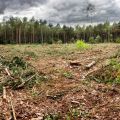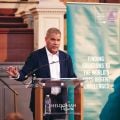The ingenuity of refugees is celebrated
A new report, published by the University of Oxford, shows how refugees are using innovation in camps around the world.
The Refugee Studies Centre has based the report on research conducted in Jordan, South Africa, Uganda, Kenya, and the United States into how refugees are engaged in creative problem-solving and entrepreneurship.
In the Za’atari refugee camp in Jordan, home to 83,000 Syrian refugees, refugees are reconfiguring the structure and lay-out of the camp and their homes in order to replicate their communities before the war broke out. They are living in 'donated' caravans, but the wooden flooring is inappropriate for them because of their regional custom of washing floors with water, which causes the wood to swell and degrade. However, they have reused the wood panelling to fashion into babies’ cribs, seating, tables, even a mobile bike stall and shop signs.
In Johannesburg, South Africa, Zimbabwean refugees are starting schools for refugees that are producing extraordinary results in high school exams.
In Nairobi's Eastleigh area, alongside refugee entrepreneurship, a film company has emerged which challenges stereotypes about Somalis.
The report uses the concept of 'bottom-up innovation' to highlight the various ways in which refugees, displaced persons, and others in crisis situations are tackling the most challenging of environments as individuals. People are drawing on their own resources in order to adapt to difficult and different circumstances.
The report suggests that rather than relying upon aid hand-outs, refugees might be better assisted if their own creative solutions were supported and nurtured. This would enable refugees, giving them better access to the internet, microfinance, education, entrepreneurship training, and basic infrastructure.
Professor Alexander Betts, Director of the Refugee Studies Centre at the University of Oxford and a co-author, said: 'There has been an emerging trend in the humanitarian sector towards using the language of innovation. Generally, though, it has focused on how to improve organisational responses. This is important but these 'top-down' approaches sometimes risk marginalizing the creativity and 'bottom-up' innovation of crisis affected communities themselves.
'In this report, we have tried to showcase examples of how refugees and displaced people innovate in their daily lives. Through examples from Uganda, Kenya, Jordan, South Africa and the United States, we highlight the ways in which refugees turn often constraints into opportunities for themselves and others. This, we suggest, has major implications for how we think about humanitarian assistance.'
The report is funded by the World Humanitarian Summit.
 Dr Ashwin Jainarayanan selected for 2024 Schmidt Science Fellow program
Dr Ashwin Jainarayanan selected for 2024 Schmidt Science Fellow program
 New study to improve vaccines and therapeutics development
New study to improve vaccines and therapeutics development
 Nature degradation could cause a 12% loss to UK GDP
Nature degradation could cause a 12% loss to UK GDP
 Alok Sharma to join the Oxford Martin School as a Visiting Fellow
Alok Sharma to join the Oxford Martin School as a Visiting Fellow
 Landmark study definitively shows that conservation actions are effective at halting and reversing biodiversity loss
Landmark study definitively shows that conservation actions are effective at halting and reversing biodiversity loss